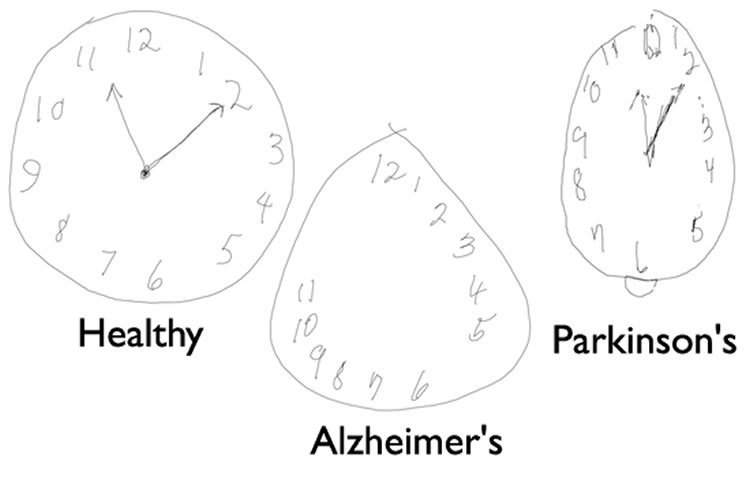Clock drawing (projective test) test

- 4753
- 518
- Perry Hirthe
The clock drawing test currently is very useful, because, It consists of a quick test to make an evaluation at the neuropsychological level, In cases of cognitive impairment.
Surely, you have thought that, just seeing the watch on your wrist, you can visualize the time, but this is not so easy for all people.
Actually, When we execute this small action we are activating a large amount of engines and cognitive processes, So, for some subjects, this may not be so feasible.
That is why the clock test is widely used today, then, it is brief and simple. Just draw a clock with a free order, or copy a drawing that has already been given.
Content
Toggle- The clock test
- The clock test application
- The evaluation of the clock test
- Bibliography
The clock test
This clock test was designed by Bettersby in conjunction with other collaborators in 1956, however, Its usefulness retains an incredible validity.
In principle it was created to detect brain negligence disorders, that is, when disabilities are presented to identify a certain type of information due to brain injuries. Therefore, with a simple drawing of a clock it was possible to detect.
However, in 1972, Goodglass and Kaplan created the clock test to evaluate other types of disabilities, such as apraxias and visOespacial agnosias.
As time has elapsed, the clock test has gained more relevance in clinical practice, especially to examine neuropsychological alterations.
Thus, in addition to viso -spatial apraxias and skills, This test also allows you to examine memory, Planning, executive functions, abstract thinking, understanding and attention.
One of the reasons why its use has become so popular is for its easy application and duration, which is short, then, it can take only two or three minutes.
However, this type of test that is fast They serve for the screening of disorders, but not to establish a diagnosis.
The clock test application
The clock drawing test is applied to two parts. The first is called “to order”, since there are no models to follow, but only the instructions are given, then, the patient is asked to draw a clock with their numbers and that, in it, indicate the eleven and ten minutes.
The second part of the application does receive the name "A Copy", since the patient is given a copy or model of a clock that also marks eleven and ten and is asked to copy it.
This test seems very simple, but the truth is that it helps identify certain alternations at the neurological level, as pointed out, since, in certain types of dementia, patients have more ease to execute the second task, that is, the copy , that the first, which consists of order. And, in other situations, the opposite occurs.
 Oxytocin and its effects
Oxytocin and its effects The evaluation of the clock test
According to the author Teodoro Oscana, in his study on the evaluation of the clock test in the screening of Alzheimer's disease, although the test seems to be a simple exam for the early evaluation of cognitive disorders in older adult patients with suspected dementia due to Alzheimer's disease, he asserts that it is really effective.
Regarding the evaluation of this test, or the clock drawing, it should be noted that there are several ways to do so. However, some errors may be present, according to the pathology presented by the patient, as well as the location of the alteration.
But, One of the criteria that is most used is the scale that ranges between 0 and 10 points, being 0 the equivalent of a totally incorrect or non -existent clock and 10 the equivalent to a completely correct clock.
Nevertheless, The score is usually divided into three sections, namely: The drawing of the sphere, the drawing of the needles and the drawing of the numbers. To each of them, a score corresponds.
The sphere is the maximum of score number 2; The needle drawing corresponds to a maximum score of 4 and, in terms of numbers, the highest score is also four.
In the two tests the same sequence is used to establish the scores. Thus, in the clock drawing test we can evaluate different aspects, such as:
- In the sphere: We can find a circular, normal; oval or with slight stumbling blocks or distortions.
- In the needles: We can visualize if the hands are in the right position or if they are the same size.
- In the numbers: It is evaluated whether they are omitted or if they are added more.
The total score of the clock drawing will arise after adding the points of both parties separately.
If the score shows a greater number than 15, then it can be interpreted that there is no presence of cognitive impairment.
But, if the score is below, then a more exhaustive evaluation is necessary to examine the capacities at the cognitive level.
Friendship Evaluation Test
Bibliography
- Custodian, n., Garcia, a., Montesinos, r., Lira, d., & Bendezú, L. (2011). Validation of the Drawing Test of the Hand-Vision-Clock-like screening test to detect dementia in a major adult population of Lima, Peru. Peruvian Magazine of Experimental Medicine and Public Health, 28, 29-34.
- Latini, m. F., Schaovsky, d., Glaser, a., Brugger, r., Zorrilla, J. P., Sousa, l.,… & Gonorazky, S. AND. (2011). The clock test: reproducibility, internal consistency and predictive variables of the clock test using the chobo score method. 985 watches analysis. Argentine neurology, 3(2), 83-87.
- Oscanoa, t. (2004, March). Evaluation of the clock test in Alzheimer's disease screening. In Annals of the Faculty of Medicine (Vol. 65, no. 1, pp. 42-48). UNMSM. School of Medicine.
- « How do the pandemic face the introverts and extroverts? 4 recommendations
- The death penalty due to lethal injection »

